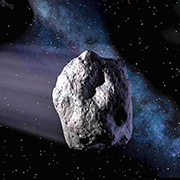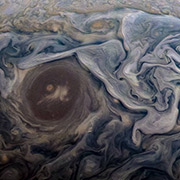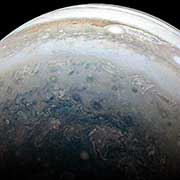
NASA’s Hubble Telescope Finds First Evidence of Water Vapor on Jupiter’s Moon ‘Ganymede’
Previous research has offered circumstantial evidence that Ganymede, the largest moon in the solar system, contains more water than all of Earth’s oceans. […]

Previous research has offered circumstantial evidence that Ganymede, the largest moon in the solar system, contains more water than all of Earth’s oceans. […]

NASA’s Hubble Space Telescope and the ground-based Gemini Observatory in Hawaii have teamed up with the Juno spacecraft to probe the mightiest storms in the solar system, taking place more than 500 million miles away on the giant planet Jupiter. […]

NASA’s Juno mission captured this look at Jupiter’s tumultuous northern regions during the spacecraft’s close approach to the planet on Feb. 17, 2020. Some notable features in this view are the long, thin bands that run through the center of the image from top to bottom. Juno has observed these long streaks since its first close pass by Jupiter in 2016. […]

In this view of Jupiter, NASA’s Juno spacecraft captures swirling clouds in the region of the giant planet’s northern hemisphere known as “Jet N4.” […]

Scientists from around the world will converge at UCF’s Florida Space Institute this week to discuss Centaurs, a type of poorly understood objects found between Jupiter and Neptune. […]

Dramatic atmospheric features in Jupiter’s northern hemisphere are captured in this view from NASA’s Juno spacecraft. […]

NASA’s Lucy spacecraft — named for humans’ earliest known ancestor, and designed to study Jupiter’s Trojan asteroids — will launch from Cape Canaveral in 2021 on a United Launch Alliance Atlas V. […]

A multitude of magnificent, swirling clouds in Jupiter’s dynamic North North Temperate Belt is captured in this image from NASA’s Juno spacecraft. Appearing in the scene are several bright-white “pop-up” clouds as well as an anticyclonic storm, known as a white oval. […]

For centuries, scientists have worked to understand the makeup of Jupiter. It’s no wonder: this mysterious planet is the biggest one in our solar system by far, and chemically, the closest relative to the Sun. Understanding Jupiter is key to learning more about how our solar system formed, and even about how other solar systems develop. […]

Striking atmospheric features in Jupiter’s northern hemisphere are captured in this series of color-enhanced images from NASA’s Juno spacecraft. […]

New comprehensive mapping of the radiation pummeling Jupiter’s icy moon Europa reveals where scientists should look — and how deep they’ll have to go — when searching for signs of habitability and biosignatures. […]

This image of Jupiter’s southern hemisphere was captured by NASA’s Juno spacecraft on the outbound leg of a close flyby of the gas-giant planet. […]